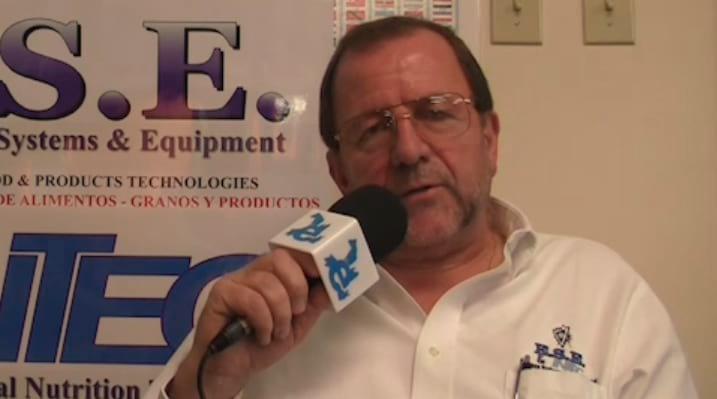Explore all the information on
Feed processing and manufacturing
Welcome to the page about Feed processing and manufacturing of Engormix; a source of knowledge on Feed processing and manufacturing.
Josef Barbi, President of E.S.E. & INTEC, and Bulent T. Helvacikara, International Sales Director, share with Engormix their point of view about the continuous growth of the animal feed industry in these regions and the products and services this company offers focused on Processing Equipment, Systems, Technologies & Complete Plant Design...
Comments : 0
Recommendations: 1
Jerry Cheng, Department Manager International for ZhengChang, talks about the performance of the company in Latinamerica, specialized in creating Feed machinery Equipment, during the Latin American Poultry Congress 2017, in Guadalajara, México.
...
Comments : 0
Recommendations: 1
.jpg&w=3840&q=75)

Benefits of rendered products on sustainability
Suggested link
Adding the proper amount of liquid raw material into the feed has become a convenient, flexible and effective way, which has been widely used in feed manufacturer. Through adding liquid, it can not only improve the feed’s energy level, but also can ensure the active ingredient in feeds to get fully utilized. Moreover, it can also improve the pellet feeds’ appearance quality and palatability in a large extent. Therefore, animals’ feed intake can...
Comments : 0
Recommendations: 0
What can we do to keep feed from being contaminated by Salmonella, increase the laying rate of hens, improve the quality of eggs, and produce raw eggs without causing foodborne Salmonella infection in humans? Only starting from the food source, speeding up the upgrading of feed processing equipment, eliminating Salmonella to the greatest extent, reducing the cost from the source and improving the egg quality. ...
Comments : 0
Recommendations: 1


Post processing for Aquafeed and pet food - Josef Barbi (E.S.E. & Intec)
Suggested link
How to clean 0.6-1.0 mm die, in a effective way?
If anyone having any practical experience or any solution or any specific mechanism.
It will help us a lot....
Comments : 0
Recommendations: 0
Hao Yun, President of ZhengChang Group, talks about the trajectory of Zheng Chang Group from China. Zhengchang, established in 1918, has made constant innovations in feed machinery industry and accumulated a wealth of experience in tackling the various challenges facing feed companies and, more importantly, is able to offer a range of comprehensive solutions. Zhengchang has now evolved into China’s largest manufacture of feed machinery...
Comments : 1
Recommendations: 0
.jpg&w=3840&q=75)

Benefits of rendered products on sustainability
Suggested link
David Meeker, Vice President of the National Renderers Association, commented on the relevance of rendering and the challenges that lie ahead for the industry, during IPPE 2017 in Atlanta, USA....
Comments : 1
Recommendations: 1
Hao Yun, President for ZhengChang Group, talk to us about the production of dies for pellet mill. With high-quality materials, ZhengChang produces more than 4000 pellet dies each year. Recently, ZhengChang has updated production equipment to machine pellet dies more efficiently.......
Comments : 0
Recommendations: 1


Post processing for Aquafeed and pet food - Josef Barbi (E.S.E. & Intec)
Suggested link
Introduction Starch is stored in plants as granules. The starch granule is a structure composed by crystalline and amorphous regions and, due to the lower order of cristallinity, the gelatinization occurs first in the amorphous region than in the crystalline region (Lund & Lorenz, 1984). When the starch granule is submitted to heat, moisture, and shear force during feed expansion and or conditioning a phenomenon...
Comments : 0
Recommendations: 2
Global human population is anticipated to increase by more than 2 billion by end of 2050 giving rise to food problem. Increase in food production will lead to more pressure on environment. So consumption of edible insects is one of the food alternatives through which one can get high quality protein, amino acids and vitamins at affordable costs. Edible insects possess high food conversion rate and emit less greenhouse gases than traditional...
Comments : 0
Recommendations: 3
.jpg&w=3840&q=75)

Benefits of rendered products on sustainability
Suggested link
Gregory Komnik, Sales Director of Insta-Pro International for SE Asia, introduces some processing technologies for food and feed during VIV Asia 2017, in Bangkok, Thailand....
Comments : 0
Recommendations: 2
The CalorMatic® is modern technology that makes heat processing of a variety of free-flowing materials simple, practical, and profitable. Natural gas, propane, or alternative fuels, in an efficient burner, heats air which passes through the fully perforated bed of the product chamber. The product is gently, thoroughly, and evenly heated to a consistent finish....
Comments : 0
Recommendations: 0


Post processing for Aquafeed and pet food - Josef Barbi (E.S.E. & Intec)
Suggested link
Automated systems for the production of food for animal and human consumption are in wide use today. These systems have enabled manufacturers to increase production and decrease both labor and variation. These systems work well for the addition of major, minor and micro- ingredients. Since micro-ingredients can be more demanding, this chapter will concentrate on inclusion of these ingredients. This chapter will show how you can plan for automatic addition of...
Comments : 0
Recommendations: 1
Brandon Fultz, Sales Representative at Sweet Manufacturing Company, introduces Sweet® Belt Conveyor Options. Sweet offers a wide variety of high -quality, efficient conveyors with a full range of capacities for both agricultural and industrial uses, such as Quick-Key® Spool Belt Conveyors and Formed Channel Belt Conveyors....
Comments : 0
Recommendations: 0
.jpg&w=3840&q=75)

Benefits of rendered products on sustainability
Suggested link
Brandon Fultz, Sales Representative at Sweet Manufacturing Company, introduces The CalorMatic®, a modern technology that makes heat processing of a variety of free-flowing materials simple, practical, and profitable....
Comments : 0
Recommendations: 0
Aidan Connolly, Chief Innovation Officer at Alltech, explained their initiative to support technology development, during Eurotier 2016 in Hannover, Germany....
Comments : 0
Recommendations: 0


Post processing for Aquafeed and pet food - Josef Barbi (E.S.E. & Intec)
Suggested link
Bühler and Protix have founded the joint venture Bühler Insect Technology Solutions. This joint venture will develop scalable, industrial solutions for the rearing, and processing of insects to provide protein primarily for animal feed and food.
China
Bühler Insect Technology Solutions is located in China and has already begun operations. “By combining the knowledge and experience of our two companies, we can provide industrial insect processing...
Comments : 0
Recommendations: 0
How can we select die plate open area or die hole quantity based on our formulation, so that we can increase the capacity and better quality.
Our extruder is twin screw. In formula protein % is around 30%, Fat below 5%, Fiber below 5%, Starch above 20%, BD 400-410 kg/l....
Comments : 2
Recommendations: 0
.jpg&w=3840&q=75)

Benefits of rendered products on sustainability
Suggested link
The International Production & Processing Expo (IPPE) is offering attendees a variety of free 20-minute technical presentations on current topics affecting the feed, meat and poultry industries. The TECHTalks program will be held in the EVENT ZONE, Booth C1305, on the trade show floor of the Georgia World Congress Center in Atlanta, Ga., from Jan. 31 – Feb. 2.
TECHTalks will provide presentations that will address many issue areas, including food safety, animal welfare,...
Comments : 0
Recommendations: 0
The use of Expanders on Solvent Extraction Plants has been implemented for several years with a high degree of success. Properly cooked and flaked oilseeds are feed into the Expander in presence of controlled temperature, moisture and residence time in order to produce collets, increasing porosity of the surface which improves the solvent (hexane) percolation into the extractor and subsequently the amount of solvent used per ton of seed is being reduced. This reduction allows to use less...
Comments : 0
Recommendations: 0













